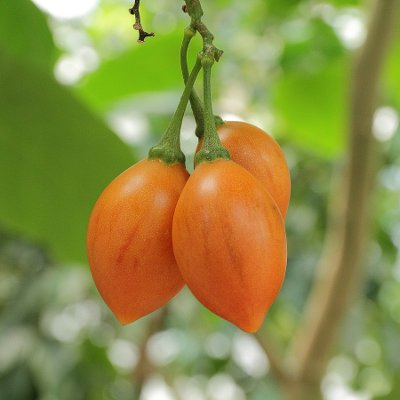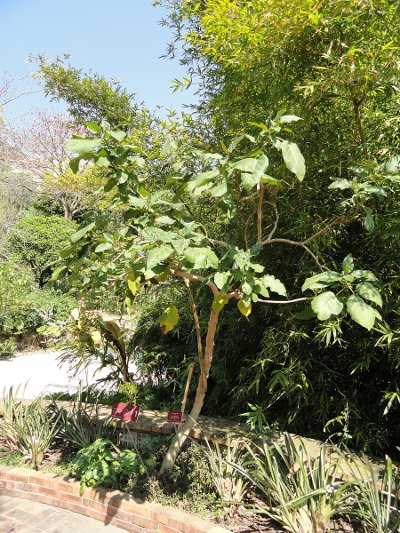Tamarillo
Scientific name: Solanum betaceum
Climate: Temperate
Plant description: It is an evergreen shrub with a gray bark, belongs to the Solanaceae family, it can measure up to 3 or 4 meters. It has oval leaves up to 30 cm long. Young leaves have fine hairs on both sides. The nerves of the blade are marked and protruding. The flowers are small, 1.3 to 1.5 cm in diameter, pinkish-white in color, arranged in small terminal clusters. They have 5 petals and 5 yellow stamens. Blooms in May-June. The fruit is a berry like an egg 4 to 8 cm x 3 to 5 cm. The skin is smooth, red or orange at maturity, with lighter lines.
It is native to the Andes, Peru, Bolivia and Northern Argentina.
Cultivation: It is multiplied by seeds, which germinate very easily with temperatures above 20ºC. Germination usually takes 20 days.It grows in humid mountainous forest climates with temperatures between 13 ° and 24 ° C, and moderate rainfall.
The plant is very sensitive to cold and low temperatures, below 10 ° C it is very difficult to survive, the heat above 24 ° C does not favor it either. It must be protected from the wind, especially when it has fruit. Often, supports are planted with ropes that hold the branches to prevent them from breaking.
It prefers fertile and fertilized soils, it is sensitive to droughts. It prefers the light of the mildest hours of the day, in the morning but not in the afternoon.
 Uses: The fruits are edible, and can be eaten raw directly or in salads or used to prepare juices, sweets and desserts. The pulp is juicy, somewhat acidic, orange to red in color, with numerous seeds. They provide iron, potassium, magnesium, phosphorous, and vitamins A, C, and E.
Uses: The fruits are edible, and can be eaten raw directly or in salads or used to prepare juices, sweets and desserts. The pulp is juicy, somewhat acidic, orange to red in color, with numerous seeds. They provide iron, potassium, magnesium, phosphorous, and vitamins A, C, and E.
It has antioxidant properties that strengthen the immune system, regulate blood pressure. It has a lot of fiber so it has a slight laxative effect helping regulate the functioning of the digestive system, avoiding constipation and improving the digestion of fats.
The fruit or leaves, previously heated, are applied topically against inflammation of the tonsils or angina especially. You should consume the fresh fruit on an empty stomach as a flu remedy. The fruit is known to have a high content of ascorbic acid.
Plagues and diseases: The plant is attacked by fungal diseases, such as leaf spots by Colletotrichum gloeosporioides, Alternaria sp. and Cercospora sp .; anthracnose or fruit rot by C. gloeosporiodes and possibly by Colletotrichum acutatum, Oidium or Ash by Oidium sp. and the death of plants associated with Pythium sp. and Phytophthora sp.
References:
Acosta, M. B. (2019, June 3). Cultivo de tomate de árbol. Ecologiaverde.Com. https://www.ecologiaverde.com/cultivo-de-tomate-de-arbol-2023.html
Cajal, A. (2019, October 15). 11 Beneficios del Tomate de Árbol para la Salud. Lifeder. https://www.lifeder.com/beneficios-del-tomate-arbol/
colaboradores de Wikipedia. (2020, July 14). Solanum betaceum. Wikipedia, La Enciclopedia Libre. https://es.wikipedia.org/wiki/Solanum_betaceum
(2018, May 14). Conocido como tomate serrano o tamarillo, es un fruto que proviene de un. DimeBeneficios. https://www.dimebeneficios.com/tomate-de-arbol/
EcuRed. (n.d.). Tomate de árbol - EcuRed. https://www.ecured.cu/Tomate_de_%C3%A1rbol
Infojardin, T. (n.d.). rbol de los tomates, rbol del tomate, Tomate arbreo del Per, Tamarillo, Tamarillos, Tomate de rbol, Tomates de rbol - Cyphomandra betacea. Infojardin. Retrieved July 26, 2020, from https://articulos.infojardin.com/Frutales/fichas/arbol-de-tomates-tomate-arboreo-tamarillos-tomates-arbol.htm
En español: Tomate de árbol

